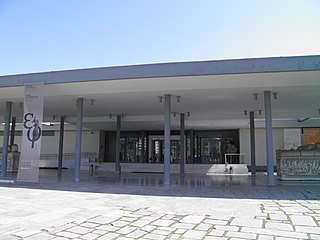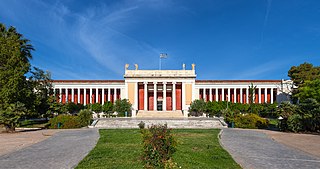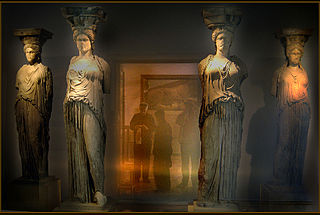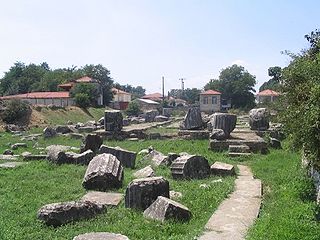
The Acropolis of Athens is an ancient citadel located on a rocky outcrop above the city of Athens, Greece, and contains the remains of several ancient buildings of great architectural and historical significance, the most famous being the Parthenon. The word Acropolis is from the Greek words ἄκρον and πόλις. The term acropolis is generic and there are many other acropoleis in Greece. During ancient times the Acropolis of Athens was also more properly known as Cecropia, after the legendary serpent-man Cecrops, the supposed first Athenian king.
This article concerns the period 479 BC – 470 BC.
In Greek mythology, Echemus was the Tegean king of Arcadia who succeeded Lycurgus.

Tegea was a settlement in ancient Arcadia, and it is also a former municipality in Arcadia, Peloponnese, Greece. Since the 2011 local government reform it is part of the Tripoli municipality, of which it is a municipal unit with an area of 118.350 km2. It is near the modern villages of Alea and Episkopi.

Scopas was an ancient Greek sculptor and architect, most famous for his statue of Meleager, the copper statue of Aphrodite, and the head of goddess Hygieia, daughter of Asclepius.

The Archaeological Museum of Thessaloniki is a museum in Thessaloniki, Central Macedonia, Greece. It holds and interprets artifacts from the Prehistoric, Archaic, Classical, Hellenistic and Roman periods, mostly from the city of Thessaloniki but also from the region of Macedonia in general.

The Siphnian Treasury was a building at the Ancient Greek cult centre of Delphi, erected to host the offerings of the polis, or city-state, of Siphnos. It was one of a number of treasuries lining the "Sacred Way", the processional route through the Sanctuary of Apollo, erected to win the favor of the gods and increase the prestige of the donor polis. It was one of the earlier surviving buildings of this type, and its date remains a matter for debate, with the most plausible date being around 525 BC. Until recently it was often confused or conflated with the neighbouring Cnidian Treasury, a similar but less elaborate building, as the remains of the two had become mixed together and earlier theoretical reconstructions used parts of both.

The National Archaeological Museum in Athens houses some of the most important artifacts from a variety of archaeological locations around Greece from prehistory to late antiquity. It is considered one of the greatest museums in the world and contains the richest collection of Greek Antiquity artifacts worldwide. It is situated in the Exarcheia area in central Athens between Epirus Street, Bouboulinas Street and Tositsas Street while its entrance is on the Patission Street adjacent to the historical building of the Athens Polytechnic university.

Stymfalia is a village and a former municipality in Corinthia, Peloponnese, Greece. Since the 2011 local government reform, it has formed part of the municipality of Sikyona, of which it is a municipal unit. The municipal unit has an area of 205.07 km2, while its population as of 2011 was 2,427. The seat of the municipality was in Kalianoi, 41 km southwest of the town of Kiato. The municipal unit occupies a mountain valley with an average altitude of 600 metres. Mount Kyllene dominates it to the NW, rising to a height of c. 2,400 metres. The largest village is Kaisari, but the principal antiquities are just south of the modern village of Stymfalia, a hamlet of about 150 inhabitants.

The Temple of Aphaia or Afea is an Ancient Greek temple located within a sanctuary complex dedicated to the goddess Aphaia on the island of Aegina, which lies in the Saronic Gulf. Formerly known as the Temple of Jupiter Panhellenius, the Doric temple is now recognized as having been dedicated to the mother-goddess Aphaia. It was a favourite of Neoclassical and Romantic artists such as J. M. W. Turner. It stands on a c. 160 m peak on the eastern side of the island approximately 13 km east by road from the main port.

The Old Acropolis Museum was an archaeological museum located in Athens, Greece on the archeological site of Acropolis. It is built in a niche at the eastern edge of the rock and most of it lies beneath the level of the hilltop, making it largely invisible. It was considered one of the major archaeological museums in Athens. Due to its limited size, the Greek government decided in the late 1980s to build a new museum. The New Acropolis Museum is now built at the foot of the Acropolis. In June 2007 the old museum closed its doors so that its antiquities could be moved to their new home, which opened on 20 June 2009.

The Antalya Museum or Antalya Archeological Museum is one of Turkey's largest museums, located in Konyaaltı, Antalya. It includes 13 exhibition halls and an open-air gallery. It covers an area of 7,000 m2 (75,000 sq ft) and 5000 works of art are exhibited. In addition, a further 25,000–30,000 artifacts which cannot be displayed are in storage. As a museum exhibiting examples of works, which illuminate the history of the Mediterranean and Pamphylia regions in Anatolia, Antalya Museum is one of the most important of Turkey's museums. The Museum won the "European Council Special Prize" in 1988.

Delphi Archaeological museum is one of the principal museums of Greece and one of the most visited. It is operated by the Greek Ministry of Culture. Founded in 1903, it has been rearranged several times and houses the discoveries made at the Panhellenic sanctuary of Delphi, which date from the Late Helladic (Mycenean) period to the early Byzantine era.

The Archaeological Museum of Olympia is one of the principal museums of Greece, located in Olympia. It is overseen by the Ministry of Culture and Sports, and, as of 2009, is directed by Georgia Xatzi. When the original building was completed and opened in 1888, it was the first museum in Greece outside of Athens.

The Norwegian Institute at Athens is one of the 19 foreign archaeological institutes operating in Athens, Greece.

The Archaeological Museum of Piraeus contains mainly sculptures, discovered in Piraeus and in the area of the Attic coast from Bronze Age to Roman times,
Alea was an epithet of the Greek goddess Athena, prominent in Arcadian mythology, under which she was worshiped at Alea, Mantineia and Tegea. Alea was initially an independent goddess, but was eventually assimilated with Athena. A statue of Athena Alea existed on the road from Sparta to Therapne. Her most important sanctuary was the famous Temple of Athena Alea at Tegea.

Gods in Color or Gods in Colour (original title in German: Bunte Götter – Die Farbigkeit antiker Skulptur is a travelling exhibition of varying format and extent that has been shown in multiple cities worldwide. Its subject is ancient polychromy, i.e. the original, brightly painted, appearance of ancient sculpture and architecture.
Ancient Greek literary sources claim that among the many deities worshipped by a typical Greek city-state, one consistently held unique status as founding patron and protector of the polis, its citizens, governance and territories, as evidenced by the city's founding myth, and by high levels of investment in the deity's temple and civic cult. The temple of the deity involved was usually founded on the highest ground (acropolis) within the city walls, or elsewhere within the central public assembly space, the agora. Conversely, a city's possession of a patron deity was thought to be a mark of the city's status as polis.

The Temple of Athena Alea was a sanctuary at Tegea in Ancient Greece, dedicated to Athena under the epithet Athena Alea; a syncretization between the Olympian goddess Athena and the local deity Alea. It was a significant Greek temple, and played a crucial part as an identity marker for the ancient Tegeans. It served as the focal point of a significant area already from tenth century BCE, and has provided evidence of contact with several nearby regions such as the Argolid and Laconia.


































